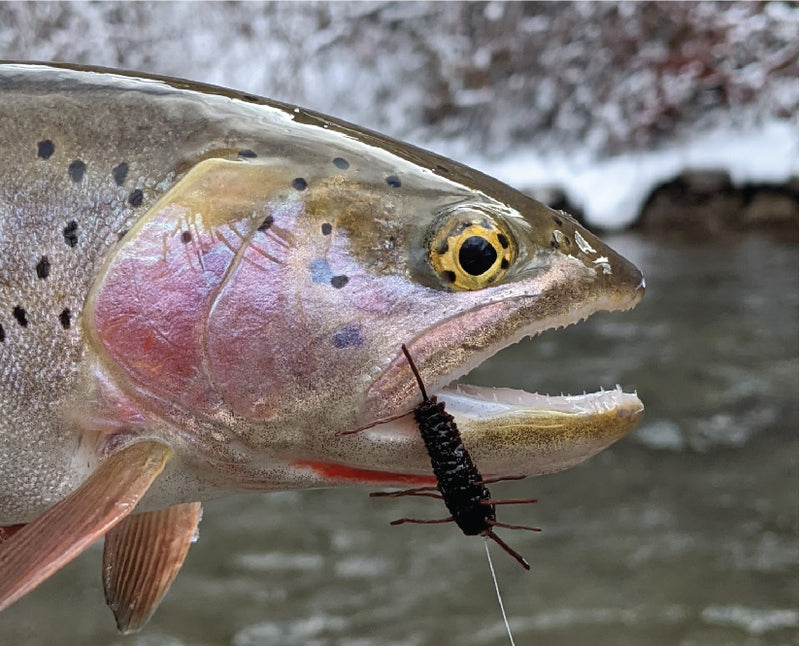What associations come to your mind when you think about salmonflies (Pteronarcys sp.)? If you’re like me, thoughts of warming weather, the transition from spring into summer, big salmon-colored insects clumsily flying in the air, and big trout splashing the surface are front of mind. However, this time of year, and adult stage of the salmonfly, represents but a small fraction of the incredible life-story of the salmonfly.
Like many aquatic insects, salmonflies spend ~99% of their lives growing and developing below water as nymphs. Additionally, salmonflies have a multiyear lifecycle that lasts 2 to 4 years in most rivers. Whether or not the lifecycle lasts 2, 3, or 4 years depends mostly on average water temperature by region. Salmonflies in colder rivers will often have longer lifecycles than their counterparts in warmer rivers because warmer water speeds up growth and development. The fact that so much time is spent in the nymph stage means that a salmonfly nymph is a solid fly pattern to throw all year long. Furthermore, a multiyear lifecycle and overlapping cohorts means that there are always several nymph sizes present at any time of the year, so it’s not a bad idea to have some large and small patterns in your fly box. I have found that my biggest patterns (size 4 or 6) work best in the spring, just prior to the emergence, when the oldest and largest nymphs are abundant and starting to get especially active.

This stunning Bonneville Cutthroat Trout couldn’t resist the size 8 salmonfly nymph imitation on a cold winter morning.

It’s not uncommon to flip over a large piece of cobble and find many different sized salmonfly nymphs. The largest nymphs will emerge as flying adults in the spring, but the smaller nymphs still have a few years of growing left to do.
Over the course of development, salmonfly nymphs grow though many instars (generally over a dozen). An instar is a growth stage in between the molting of the exoskeleton. You can think of the molting process a little like a kid outgrowing his or her old clothes. In the case of the salmonfly, that old exoskeleton starts getting a little tight around the sleeves and eventually the salmonfly nymph breaks open and sheds the old exoskeleton, exposing a fresh and roomier exoskeleton that had been growing underneath the old one. For a short time, the new exoskeleton is noticeably lighter than the old one, but eventually darkens up. If you see an unusually light-colored salmonfly nymph, it probably just molted.

An unusually pinkish color suggests this salmonfly nymph molted very recently.
By now you may be wondering what a salmonfly nymph eats to fuel the incredible growth through all those instars. To a salmonfly, a favorite meal consists of a decaying leaf with a nice fungal and microbial spread. These microorganisms on the decaying leaves are the peanut butter on the cracker, so to speak, and help the salmonfly really pack on those pounds. Ecologists call insects that eat leaves “shredders” because they have specialized mouthparts for shredding leaves. Don’t you love a good common-sense name?! After chowing down, all that is left are the skeletonized remains of the decaying leaf. Shredders play an important role in river ecosystems by processing leaves and recycling nutrients. In fact, other types of insects, that ecologists call “collector-gathers” and “filterers” rely on shredders (which are notoriously messy eaters) to make small bits of scrumptious leaf material accessible to them in the water column. It’s hard to find a happier bug than a collector-gatherer just downstream of a salmonfly nymph that is messily chowing down on a nice decaying leaf - bon appétit!
It does not take long for a few salmonfly nymphs to skeletonize a scrumptious decaying leaf!

So, next time you’re standing knee deep in the river surrounded by flying salmonflies and splashing trout, give a nod to the nymph and the remarkable underwater journey that preceded such an incredible event!
-Donny

